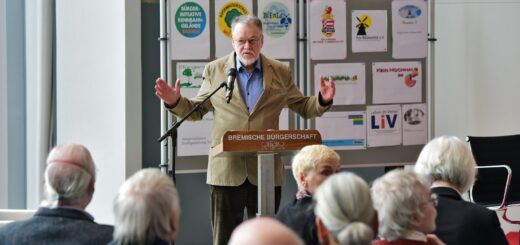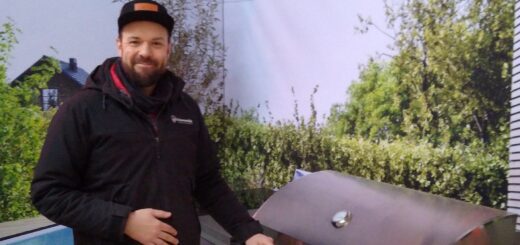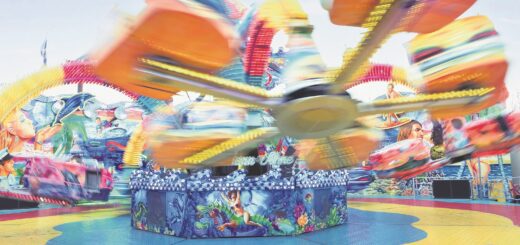The school houses the school museum. "Our focus is on placement work and we mainly target schools," explains museum director Frauke Hellwig. If National Socialism is on the curriculum, for example, the exhibition can be used to illustrate everyday school life at the time, including propaganda.
Separate schools for boys and girls
The collection has continued uninterrupted since 1983. The beginning is marked by the imperial era with the introduction of compulsory education. Even the building gives a clue: divided into two parts with the gymnasium in the middle, boys and girls still attended separate schools back then and learned different things.
While the boys in Kaiser's day had the subject of spatial education, the girls learned handicrafts. Photo: Fuller
In addition to a large collection of school photos dating back to 1900, the school museum has a number of exciting exhibits: ancient teaching aids such as sto
nts and murals, schoolbooks, report cards, satchels, interviews with contemporary witnesses and entire classrooms show how and what children learned in Bremen at different times.
Experience lessons as they were back then
School classes can even slip into aprons and sailor shirts and experience how it felt to sit in rigid rows of benches. "The worse a student was, the further back he sat," Hellwig explains.
Pupils can slip into aprons and sailor shirts. Photo: Fuller
One of their favorite exhibits are tapeworms and roundworms preserved in formalin. "Public health was a subject in class, and the children learned what parasites can infect humans," says the museum director.
Major topic: National Socialism
In addition to the imperial era and the Weimar Republic, National Socialism and Bremen's reform pedagogy form other major thematic complexes. "Each partial exhibition began as a special exhibition and was then permanently integrated," says Hellwig.
The exhibits come from Bremen schools and private donors. Mainly testimonials and photos are brought to the museum director. "We no longer accept schoolbooks, we now have around 50.000 pieces and almost every one of them should be there," says Hellwig.
School cones and cheat sheets
Notebooks, report cards and letters of apology also reveal a lot to her and visitors about the respective political u
nd family circumstances. "In the meantime, we're looking for things like this from the more recent past. And we also have very few school bags," adds the museum director.
She would also be happy to hear about cheat slips or love letters.
In the meantime Hellwig is plagued by a lack of space. "There is still so much to show, but unfortunately we no longer know where."
The School Museum is participating in the Long Night of Museums with a storytelling cabinet on Saturday, 25. May. Actor Martin Lebmann tells at 18.30, 20.30 and 22.30 o'clock in the old lecture hall the most beautiful animal fables.
Open: Monday, Tuesday and Friday from 9 a.m. to 2 p.m., Wednesday and Thursday from 9 a.m. to 4 p.m., and by appointment. Guided tours and programs for groups by appointment. Prices: Adults 3 euros, reduced 1.50 euros, families 5 euros.
These articles might also interest you.

The heart of democracy

Supervised barbecue

Hype instead of balcony
7 answers
I read with joy: "From the seventies, there are just some pictures of teachers and students of the Admiralstrabe in Findorff in circulation." I am very interested in this! My question: Could I see the pictures sometime? Can I do that in the school museum? Because that is where they belong!
Martin Korol, Bremen
These are strange allusions? Is there a conspiracy in Findorff? Five questions and one answer come to mind: 1. What is "social fascism" and what does a fight against it look like?? (This must be a world apart. I, at least, do not know them and I am quite worldly experienced. I think "Bremer against social fascism" is simply a head birth.). 2. Can I/can one look at the said pictures of a tank ride in the school museum then now? 3. May a captain of the reserve be a class teacher and NPD-member? 4. May a catholic be friends with him? 5. May Gunnar-Eric Randt in the WR show himself with such an enemy image as he does in his commentary? Answer: Yes, we live in such a free state. May it please remain so.
Martin Korol, Bremen
Well, I have five questions and one answer for Gunnar-Eric Randt: 1. What is "social fascism? and how does a fight against it look like? (This must be a world of its own. I for one don't know them and I am quite worldly wise. I consider this world simply invented, a head birth.). 2. Can I/can you look at the said pictures of a tank ride in the school museum now? If not, why? 3. Was/is a captain of the reserve allowed to be class teacher and NPD member? If not, why? 4. May a Catholic be friends with him? If not, why? 5. May a citizen named Gunnar-Eric Randt be as denunciatory in the WR as an IM was in the GDR? Answer: Yes, in such a free state we live. Please keep it that way.
Martin Korol, Bremen
Bremer against social fascism From the seventies some pictures of teachers and students of the Admiralstrabe in Findorff are in circulation. Maybe one or the other photo of the tank ride of a sixth grade class on the military training area of Schwanewede will find its way into the school museum. I would be pleased. Does it show a captain of the reserve, who was a class teacher and NPD populist, and his Catholic friend, who still lives in Findorff today. The Martin Luther parish was unfortunately never willing to have an exhibition on this curated by the photographer, and to invite the two still living officials to a discussion forum. The former principal of the school center on Regensburger Strabe also prefers to keep quiet about it, even though the right-wing populist's friend later taught there as well.
Small question: What does the sentence "Bremer against social fascism" mean?? I have read about Italian fascism under Benito Mussolini; Spanish fascism under Franco and Portuguese fascism under Salazar. There were others and in addition the National Socialism. That was not fascism. He was 1000 times worse. And what is "social fascism" now?? I have searched the whole library of the Bremen School Museum for them, 50.000 books, but was not found.
Martin Korol, Bremen
Also in private archives of Bremern still lie many Arte files from long past school time.
Even the private archives of Bremen citizens still contain many memories of the school days of several generations. The school books and exercise books from the war time are a special souvenir for them.